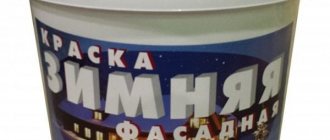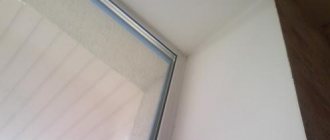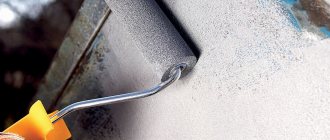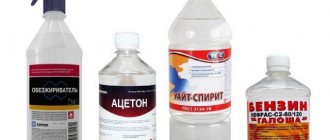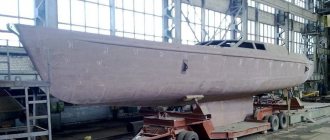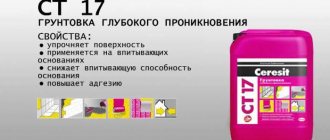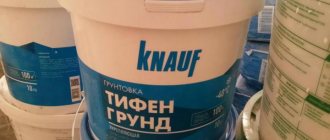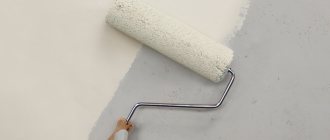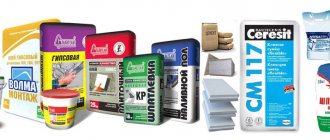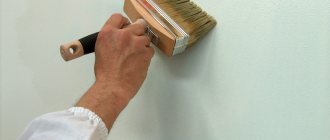Precautionary measuresParameterMeaningAppearance of the film: Red-brown (gray, white), semi-gloss or matte texture. Homogeneous, smooth, without delaminations and craters Degree of grinding 40 microns Conditional viscosity 45 Drying time to the third degree at a temperature of 20 ° C 12 hours Elasticity when bending 1 mm Impact strength 50 cm Film hardness 0.35 Film adhesion no more than 1 point Consumption per layer 60-100 grams per 1 m² Non-volatile substances, % 54-60
The quick-drying gray primer has distinctive characteristics in a number of positions:
- proportion of non-volatile substances – 60-70%;
- film hardness – 0.1;
- viscosity – 80.
Consumption
The amount of material applied will depend on the application method itself.
The consumption rate for GF-021 primer per 1 m2 of metal will be in the range of 60-100 g of material to cover one layer.
Color palette
Usually the primer is red-brown and gray, but black primer can be ordered. The quality and color saturation is determined by the delivery of a specific batch.
Storage conditions
It is necessary to store in a basic container, maintain the humidity level to 80%, and keep out of direct sunlight. Freezing of the composition is only possible down to -20°C. Under such conditions, the shelf life will be two years.
Security measures
Due to the solvent content in GF-021, the composition has a detrimental effect on the human body with its toxicity, so the use of personal protective equipment is a necessary measure. It is worth protecting the skin, mucous membranes, and respiratory organs.
Be sure to wear goggles, a respirator, gloves, and clothing that fits tightly to the body so that accidental contact of the primer with the skin is unlikely. During priming work, it is recommended to wear special protective overalls.
The soil is highly flammable. Fire safety measures are provided. It is prohibited to use any fire near the mixture (cigarettes, lighters). To reduce the amount of toxic fumes, artificial (hoods) and natural ventilation (opening all doors and windows) is provided. If the mixture comes into contact with the skin, the latter should be washed with soapy water.
After complete drying, the primer has no harmful effects on the body and is absolutely safe.
Primer consumption rates
For different primers and materials, this figure will be completely different.
However, it must take into account the requirements of GOST. OSB boards: technical characteristics, types, sizes, painting
How many bricks are in a pallet: calculations
Below are the consumption rates for the most popular types of primer:
- Concrete contact (concrete contact, concrete contact) – up to 350 g/m2. It is mainly used to prepare dense areas with low moisture permeability.
- Strengthening (deep penetration) – 0.1 kg/m2. It is used to strengthen weak, crumbling surfaces.
- Special primer for working with decorative plaster – 0.2 ml/m2.
- Alkyd primer – 0.12 kg/m2. This primer is used to treat wood, chipboard, plasterboard, and fiberboard.
- Water-dispersed – 0.1 kg/m2.
- Facade with acrylic base – 0.15 kg/m2.
- Wallpaper primer – 0.12 kg/m2.
- Primer for wood or metals before painting with enamel – 0.12 kg/m2.
- Anti-corrosion – 0.08 kg/m2. It is used to treat ferrous metal before applying paint.
- “Optimist” – 125-250 ml/m2.
- VL-02 – 0.12 kg/m2.
Consumption table for various types of primers
| Type of primer | Consumption rate | additional characteristics |
| Concrete contact | 350 g/m2 | It has a high level of adhesion (cohesion), designed for processing dense surfaces with low absorbent (absorbing) properties. Used before covering the work surface with tiles or plaster. |
| Alkyd primer | 120 g/m2 | For processing plasterboard, as well as wooden surfaces, chipboard (chipboard), fiberboard (fibreboard). |
| Water-dispersed | 100 g/m2 | Used to prepare the working surface for painting. |
| For decorative plaster | 200 g/m2 | During finishing work before plastering. |
| Specialist. primer before wallpapering | 120 g/m2 | No |
| Universal for metal and wood processing | 120 g/m2 | Used to prepare the surface for enameling. |
| Universal type "Optimist" | 125-250 g/m2 | This is a mixture of several types of specialized primers. Well suited for both metal surfaces and wooden or concrete-stone surfaces. In the instructions for use, as a rule, the proportions for each type of base being processed are written. |
| Anti-corrosion / Primer VL-02 | 80 g/m2 / 120 g/m2 | Necessary before painting surfaces made of ferrous metals (iron, cast iron, steel). |
Brick Density
How many tons of crushed stone are there in a cube?
Drawing conclusions, it is worth noting that when using a primer you need to adhere to some rules. If you are given advice that you need to buy more primers than you think, do not rush into the purchase. You can do this at any time. But if there is excess primer left, then its shelf life may be exhausted, and the money will be spent in vain and wastefully. You can always buy more primer.
When working with soil materials, adhere to safety regulations for working with such compounds. Study the detailed description of the priming work. Be sure to wear gloves when priming surfaces. Don't forget about a respirator and safety glasses. Keep the primer out of the reach of children
We recommend reading
Cement consumption per 1 cubic meter of concrete
Consumption of water-based paint per 1m2
How many bricks are in one cube (1m3): calculations
What are primers used for?
The primer penetrates the surface layers of the material, strengthens them, improves the adhesion of the material, and compacts it. In addition, primers reduce the absorbency of the material and thus save you paint or wallpaper glue. Some primers contain special antifungal agents and thereby protect you from this trouble. If you want your renovation to last for years to come, you simply need to use primers.
Applying primer
Different types of primers are used for a variety of jobs, for different materials. Currently, there is a rich palette of different primers for any occasion. They are different in composition and may contain various oils, resins, pigments, and varnishes. Primers are available for metal and wood, special or universal. Modern primers differ in their viscosity, density, color and drying time.
What determines primer consumption?
Properties and features of the use of AK-070 primer
The consumption of deep penetration primer per 1 m² varies due to several factors:
- Surface to be treated. The amount of primer material used for drywall, wood and metal differs significantly.
- Method of applying the mixture. If it is applied with a spray bottle, it will not go away so quickly, but if it is applied with a roller, it will go away faster.
- Base structures. For porous material, more mixture is needed to cover all the unevenness.
- The type of soil that is used. The amount of protective composition per unit area depends on the type of soil.
- The number of layers that will be applied. Accordingly, the more layers, the more soil needed.
- Temperature and humidity. To ensure that the use is not too abundant, it must be done in a warm, dry room.
The packaging of the primer liquid indicates the average consumption of the mixture. But it must be remembered that under real conditions this amount may vary. It all depends on the above factors.
This video explains what soil consumption depends on:
Primer consumption for metal per 1m2
For metal work, choose primers without acrylic. Because acrylic cannot prevent rust. Before applying primer to metal, it must be prepared. If the item has been in use for a long time, it may develop fluffy rust or areas of flaking iron. You need to get rid of them using appropriate tools, for example, iron brushes. Since porous, aged metal tends to absorb both dyes and soil. Thus, without proper preparation, soil consumption can increase by 2 or more times.
An epoxy resin-based primer is best suited for such purposes. It is suitable for both metal and concrete structures. According to general recommendations, the primer consumption for metal will be 60-100 g. This is the minimum figure among all types of surfaces.
How to reduce primer consumption
Choosing a primer for walls: everything you need to know
Also, if desired, you can slightly reduce the primer consumption using three methods:
- Purchase cheap impregnations that will fill the pores in the wall and reduce primer consumption by 10-30%.
- More economically and measuredly, the composition is applied to a completely dry base.
- If you use a brush, you can save 20% of the mixture.
If you use these tips, then in such an easy way you can reduce the consumption of the composition, as well as increase the quality of material processing. Thus, you can purchase a more expensive composition, but optimize its use.
Application with a brushSource sdelaipotolok.com
Consumption of concrete contact primer per 1m2
Concrete contact is one of the new types of primers. It is used on dense surfaces with a low degree of moisture absorption. At the same time, it dries as quickly as possible, which allows you to begin subsequent surface treatment in a short time. It allows you to create a rough texture on the surface of the workpiece, which allows you to retain subsequent layers of paint, plaster, etc. The average rate of its use is primer consumption per 1 m2 of 200-500 g. We discussed the use and consumption of concrete contact primer in more detail in the previous article.
Consumption of concrete contact primer
What is the electricity consumption of an electric boiler based on the area of the house?
Concrete contact consists of a building mixture (cement, sand, as well as special additives) and acrylic. It is often used to better bond the base, which almost does not absorb moisture before plastering, as well as before laying tiles or other finishing work.
This mixture has a number of advantages:
- dries quickly, which allows finishing within a couple of hours after applying the mixture;
- does not allow water to pass through due to the film created during drying;
- can last up to 80 years.
The quality of the repair will be good thanks to the use of such a primer.
The consumption of concrete contact per 1 m² depends on the characteristics of the base that needs to be processed. Basically, a lot of primer is needed on a porous surface, of which there are 3 types:
- Absorption into brick or sand concrete occurs quickly, which allows the consumption of concrete contact per 1 m² to be up to 500 g.
- Average porosity of concrete or tiles. The consumption for them is approximately 300 g per m².
- 100 – 200 g per m² of primer is necessary for low-porosity surfaces.
Before using this mixture, it is necessary to determine the type of surface, as well as how much primer will be needed.
This video explains the benefits of concrete contact:
Consumption of primer mixture for metal per 1m2.
When priming metal, specialists choose a mixture without acrylic. Because acrylic does not prevent iron from rusting. The metal surface must first be prepared. It should not show any rust or flaking iron. If they are still present, they need to be removed with special tools, such as a dart brush. Because an old porous steel surface with defects tends to absorb both paint and primer. If cleaning is not carried out, the consumption of the mixture per square meter can increase by 2 times.
For priming metal, an epoxy resin-based primer is best suited. It is intended for iron and concrete structures. According to general standards, the consumption of primer for metal finishing will be from 60 to 100 g. This is the minimum figure among all framed surfaces.
Primer GF-021 (The most popular mixture for metal)
Liquid "GF-021" is a suspension of fillers and pigments in an alkyd-based varnish with the addition of a drier, stabilizers and solvents. The composition is intended for metal and wooden substrates for coating with various enamels.
The consumption of GF-021 primer per 1 m2 of metal is specified in the standard and is 60-100 grams per layer. Of course, when calculating the amount of soil required for work, do not forget about a couple of subtleties.
- The consumption of GF-021 metal primer increases as it thickens. The soil willy-nilly lays down in a thicker layer.
- On porous surfaces it also increases: part of the primer is absorbed into the base.
Technical characteristics and consumption of primer mixture: Table.
| Film color and texture. Film appearance | Red-brown (gray, white), semi-gloss or matte texture. Homogeneous, smooth, without delaminations and craters |
| Grinding degree | 40 µm |
| Conditional viscosity | 45 |
| Drying time to the third degree at a temperature of 20? C | 12 hours |
| Flexural elasticity | 1 mm |
| Impact strength | 50 cm |
| Film hardness | 0,35 |
| Film adhesion | no more than 1 point |
| Film resistance to static liquid exposure 20? C | |
| sodium chloride/mineral oils | at least 24/48 hours |
| density | 1.25-1.3 kg/l |
| Consumption per layer | 60-100 grams per square meter |
| Non-volatile substances,% | 54-60 |
Betonokontakt Knauf
Also, the sweep consumption depends on the manufacturer. Different manufacturers have their own composition and proportions, which changes the amount of material consumed. For example, you can consider the consumption of Knauf Betokontakt primer per 1 m², its properties and consumption.
This mixture is used for foundations that do not absorb moisture or do so poorly. In this way, the material for plaster or putty is prepared. You can also consider the technical characteristics of the Knauf Betokontakt primer, which also includes the composition consumption:
- dries in less than a day;
- good concentration;
- applied by roller or mechanically;
- mixture consumption is 250-350 g per 1 m², taking into account that the material was not previously diluted.
The composition can be used for concrete, monolith, reinforced concrete, plasterboard or expanded polystyrene. It is also suitable for application to plaster or before gypsum-lime plaster is used.
Bucket of Knauf mixtureSource materik-m.ru
Briefly about the main thing
The primer is necessary so that after applying it, glue, paint or other wet compounds can be used without effort on the base.
Primer consumption depends on the condition of the base. You can also calculate it if you apply the composition to a piece of wall approximately 1 by 1 m, and then calculate how much mixture was used.
Concrete contact mixture is considered the most durable among the others. Of these, Knauf is considered the highest quality, which lasts up to 80 years and holds the base well with other materials.
Making a deep penetration primer with your own hands
Construction compounds with the specified characteristics do not have to be purchased at hardware stores. You can do everything yourself. Any home craftsman can handle this job. The main thing is to maintain proportions.
The list of required ingredients is as follows:
- 2 parts laundry soap 60%;
- 5 parts bone wood glue;
- 1 part copper sulfate.
To prepare, take a pan or bucket with enamel. It is prohibited to use the same container for food later; there is no universal type of utensil in this regard.
It is better to prepare a regular mixer or immersion blender in advance. They will help get rid of lumps that may form during work.
It is important to protect against breakdowns in such equipment. The process itself looks like this:
Pour cold water into the container and bring to a boil. Grind or grate laundry soap on a kitchen grater. The resulting mixture is added to the container, then the fire is turned to the minimum level. A wooden stick or spatula is used to stir the mixtures for some time. Copper sulfate and wood glue are added to the solution. The container is covered with a lid. Leave everything to cook for half an hour using low heat.
It is important to stir the composition periodically, then it is easier to avoid lumps. After half an hour, the solution is removed from the heat and filtered. After cooling, the wall can be coated with the composition without any problems.
PVA glue is often used as a base; it is also suitable for this type of work. Simplicity and convenience are the main advantages characteristic of this method of preparation. The technical regulations confirm this.
Simplicity and convenience are the main advantages characteristic of this method of preparation.
Residues of mixtures are difficult to remove, so it is recommended to take care of protecting the furniture before starting work. Deep application primers mostly involve the use of acrylic resins as a base. The quality of different types of products is approximately the same, but domestic developments are cheaper.
Consumption rates
Typically, the manufacturer provides primer consumption rates in the form of visual instructions placed on the packaging. However, despite this, these calculations are approximate, and there is no need to strictly follow them. Depending on the surface and subsequent actions, primers can be applied in two or even three layers. The first layer is completely absorbed by the base. And the next layers of primer will become the base for subsequent finishing.
The standards are also influenced by the experience of the master and the technique he uses when applying primer to the surface. This can be a brush, roller, spray bottle, or a homemade device.
Consumption of GF-021 for metal per 1 m2
Speaking about the peculiarities of the consumption of the building material in question, it should be noted that after applying the solution, a very thin (up to 1 mm thick) layer remains, which has high strength indicators. Practice shows that under normal environmental conditions, which consist primarily of positive temperatures, the applied layer can dry in a minimum amount of time - 50–60 minutes.
Speaking about the consumption of GF-021 per 1 m2 of metal, it should be noted that to cover the specified area you will need from 60 to 100 g of the product, depending on the quality of surface treatment planned.
In order to apply the product, you can use both mechanical and manual methods. Construction experts recommend using manual ones, citing the fact that in this case the consumption of GF-021 for metal per 1 m2 will be much less. You should not do this with a roller, which absorbs most of the material.
Tips and tricks
If all the calculations have been made and the primer has been purchased, it is important to treat the base so that the paint lays smoothly and beautifully, and the coating retains its impeccable appearance for a long time. This problem can be solved by performing the work strictly according to technology, as well as taking into account the recommendations of experienced specialists in this field
- Primer is applied to the walls from bottom to top.
- Before priming, it is necessary to prepare the base (level it, clean it of dirt, dust, old layers of paint, wash and dry it). Metal surfaces should be free of rust.
- The sprayer saves the consumption of the composition, but the roller increases it.
- Before priming, you should thoroughly clean off any pockets of fungus and dark mold spots, and additionally treat the affected areas with an antiseptic.
- Hard-to-reach places can be easily coated with a thin brush.
- Many manufacturers produce entire series of products for sequential technological work. For example, you can purchase plaster, primer and paint from the same brand, which are completely compatible with each other. Using such series, owners get better results.
- Do not dilute the paint with a primer; this does not give the paint the desired properties.
- After applying the first layer of primer, you should wait the time indicated on the packaging and only then apply subsequent layers.
- When purchasing soil, you should make sure that the packaging is intact and check the expiration date of the product.
In the next video you will find the secrets of choosing materials and tips from a professional for the perfect primer.
Advantages and disadvantages
This type of primer has a number of positive qualities, but there are also some disadvantages. Let's take a closer look at the main positive qualities of the substance:
- this type of primer is universal and suitable for treating any surface indoors or outdoors;
- the composition is characterized by improved adhesion and, in addition, rapid hardening, which significantly saves time during work;
- these substances are not very expensive, which allows them to be used on any budget;
- This coating option is easy to apply even by inexperienced specialists, or by those performing repair work for the first time.
Despite a number of advantages, there are some disadvantages regarding this substance. Small temperature range for coating. The composition penetrates deeply, which may result in overconsumption. This substance has a strong odor that can cause poisoning.
Primer consumption rates
The rate of consumption of the primer mixture depends on the structure, as well as the characteristics of the base on which it will be applied:
- When priming metal that does not absorb the composition, 80-90 g of primer is used for each m². It is determined by brand and consistency.
- To superficially treat drywall, you can use a universal primer, which is applied in one step. Consumption per m² will be 95-115 g.
- For plaster that is very porous, it is necessary to apply the composition in two layers. Consumption per m² is approximately 180-200 g.
- The wood is coated with a heavy-duty primer. 120-150 g per m², depending on the structure.
For a more accurate calculation, you can make a sample and determine how much primer you need to buy. All numbers vary depending on the surface, its structure, as well as the experience of the master who will apply the mixture.
Wood coated with primerSource img.aviarydecor.com
Consumption of acrylic primer per 1m2
Acrylic primer is easily diluted with water in the desired ratio and is usually distributed in powder and concentrated liquid form. Its structure resembles whitewash, so it is not recommended for priming black surfaces to avoid streaks. Acrylic primer is usually consumed in a volume of 120-150 g. The consumption of acrylic primer is mainly used for implementing design solutions indoors using putty, plaster, as well as when preparing walls before gluing or covering. It is also used as a universal base for painting with acrylic paints.
Primer consumption per 1m2: what is it for and consumption rates
Primer is the main stage of finishing work. You can glue wallpaper, prepare to work with drywall, apply plaster, but you will begin all these processes with a primer. Priming means applying several layers of primer to the work area.
Although the priming process will not be noticed by anyone, this is where any work related to finishing should begin. To prime surfaces, you need to know the proportions in using this material. Without this knowledge, you will not be able to do correct and high-quality work. Moreover, you will not be able to calculate the required amount of money to purchase the required amount of material.
Saving mixture
It will not be possible to reduce material consumption. Manufacturers warn that the liquid solution can lead to a decrease in adhesion, that is, the concrete contact will not be able to adhere to smooth surfaces. In addition, during operation, the uniformity of drying is disrupted. Water evaporates or is absorbed into the substrate too quickly, preventing it from producing good adhesion. As a result, heavy fractions simply fall off.
Minimal losses are the formation of cracks, which will still entail a complete rework, and therefore a double waste of money. The watery composition also reduces the waterproofing properties of the future surface.
What factors influence changes in the proportions of soil consumption rates?
When calculating how much primer is needed per 1 m2 of surface, it is necessary to take into account that the amount of primer composition varies depending on certain factors:
- material of the processed surface. The amount of soil used to treat drywall, wood and steel varies significantly;
- method of applying the primer mixture. When spraying the primer with a spray gun, the consumption decreases, and when applied with a roller or brush, it increases;
It’s easy to calculate your soil needs on your own using a regular calculator.
- structure of the protected base. For example, for aerated concrete, the primer is consumed in an increased volume, which is due to the porosity of the material;
- type of soil used. Depending on the type of soil and its purpose, the amount of protective composition per unit area changes;
- number of applied layers of soil. If two-layer priming of the surface is necessary, the need for material increases;
- temperature and humidity. To optimize soil consumption, its application should be carried out in a dry room at a positive temperature.
Primer liquid is sold in specialized stores in sealed packaging, which indicates the average consumption of the composition. In real conditions, the amount of soil consumed varies depending on a set of these factors.
Primer consumption rate depending on surface characteristics
Depending on the characteristics, the primer consumption per m2 of wall differs
Let's consider the approximate consumption of priming liquid when applied to various materials:
- When priming a metal base that does not absorb the working composition, 80-90 g of primer is consumed for each square meter of surface. Consumption is determined by the brand of soil used and its consistency;
- For surface treatment of plasterboard sheets, universal-purpose primers are used, applied in one step. Processing a plasterboard base will require 95-115 g of acrylic primer per unit area;
- The plastered wall surface, characterized by increased porosity, requires a two-layer primer. In this case, the total consumption of the primer composition per square meter of base will be 180-200 g;
- Wood surfaces, as well as bases made of particle boards and wood fiber boards, are coated with alkyd primers. Depending on the structure and moisture content of the base, the consumption is 120-150 g/m2.
After performing a test coating of the surface being treated, it is easy to determine the actual need for a primer composition. Actual values may differ from the standard values depending on the structure of the surface and the qualifications of the specialist applying the primer to the base.
It is easy to determine the actual need for a primer by performing a test coating of the treated surface
Methods and technology for applying primer
Roller and tray with rolling surface
Primer application can be done using manual or automatic tools. Hand tools – brush, brush or lint roller. Power tool – spray gun or primer spray gun.
When working on a small area, it is optimal to use a lint roller with a long handle and a tray for paint and varnish mixtures. The tray must have a rolling surface to remove excess soil from the surface of the roller.
Before applying primer to the wall, it is recommended to go over the surface with a spatula. This will remove remnants of large particles of dust, plaster, putty, etc. Preparing the mixture for use is carried out according to the instructions on the packaging.
https://youtube.com/watch?v=EZiuYQB66js
The primer is applied to the wall using a rolling motion from top to bottom. When working, you should take your time and carefully monitor drips and excess soil on the working surface.
It is better to use a brush to process corner joints and mates, since the roller treatment area does not cover small areas.
Primer consumption per 1 m2 depending on its type
There are many types of pre-treatment materials. The correct choice of the most suitable one for each type of work will help not only reduce consumption, but also improve the quality of subsequent finishing. Even a universal primer will give different coverage on different surfaces. When calculating, it is necessary to take into account not only the composition of the primer, the approximate proportions from the manufacturer, the material of the surface to be treated and the type of paint or glue that will be applied to the primer. Factors such as time of year and weather conditions that affect humidity and air composition also play a role. In addition, it must be remembered that by applying the primer with different tools, you can increase or decrease its consumption. The most economical way is to apply it using a special sprayer.
Please keep in mind that the numbers below, as well as those on the packaging of the primer you choose, are not completely accurate. In addition to the factors listed above, the cost will also be affected by the professionalism of the person carrying out the work. Without experience working with the material, you will almost certainly spend more than the average indicated consumption per 1 m2. On the contrary, knowing the composition and all the properties of the material, you will understand how you can reduce its consumption.
Primer consumption "Betonokontakt"
From the name it is clear that this material is intended for pre-treatment of concrete surfaces. However, it is also suitable for other surfaces that have a weak ability to absorb liquids. The adhesion - or adhesion - of this primer is very high. Another advantage is that it dries quickly (about an hour).
Different manufacturers may give different consumption data. However, on average it will be about three hundred and fifty grams per 1 m2. In fact, it can purely fluctuate from two hundred to five hundred grams.
Consumption of deep penetration primer
This type of primer can be called universal, as it is suitable for different surfaces. But the best results can be achieved with it when used on loose, porous surfaces. For example, such as chipboard, cinder block or foam concrete. The high level of adhesion of this material makes its adhesion to the surface very strong and reliable. Depending on the manufacturer, the primer consumption per 1 m2 can be indicated on the packaging from one hundred to one hundred and eighty grams.
Alkyd primer consumption
This primer is used for pre-treatment of plasterboard surfaces before wallpapering. It is also suitable for surfaces made of wood, fiberboard and particleboard (fibreboard and chipboard). Depending on the manufacturer, the consumption indicated on the packaging can vary from one hundred to one hundred and fifty grams per 1 m2.
Acrylic primer consumption
This primer is available in two versions - liquid and powder concentrates. Each of them must be diluted with water in the proportions indicated on the package. It is then most often used to treat surfaces before wallpapering, drywalling or painting. You should know that acrylic paints work best on acrylic primers.
It is also important to understand that due to its structure, acrylic primer can streak on dark and black surfaces. Typically, manufacturers indicate on packaging consumption from one hundred to one hundred and fifty grams per 1 m2
Some types of acrylic primers are suitable not only for interior, but also for exterior work.
Primer consumption for metal
For metal, you can use different, not necessarily specialized, primers. The main thing is that they are not acrylic. Because if there is corrosion on the metal surface, it will “eat” the acrylic. An epoxy primer is best for pre-treating metal surfaces. Before applying primer, the metal must be prepared in a special way, this will help reduce consumption. If this is not done, then 1 m2 will require an average of one hundred and twenty to two hundred grams of primer. After processing, this amount will decrease to sixty to one hundred grams.
There are also special anti-corrosion primers. They are applied to ferrous metal surfaces before painting. Manufacturers indicate the consumption of such a primer from eighty to one hundred and twenty grams per 1 m2.
Primer consumption for metal per 1 m2: how to calculate
Strict compliance with GOST is one of the indispensable conditions by which the quality of a product can be judged. As for the primer specifically, there are a number of characteristics for it.
Namely:
- Color;
- Viscosity;
- Density, consumption;
- Drying time.
Very often, the consumer, in order to understand how many cans (kilograms) he needs, asks the following question: - What is its consumption, and how much should I buy?
Depending on the purpose, as well as the type of surface to be covered, there are the following types:
- Primer GF-021 . The established consumption rate is 120 ml/m2. It is used for priming surfaces of both metal and wood.
- Primer for galvanized metals . The established consumption rate is 80 ml/m2. By using this primer, we “acquire” excellent adhesion.
- Primer VL-02 . The established flow rate is 80-120 ml/m2. Applied to a metal surface before subsequent paint coating.
Thus, you can judge the approximate consumption of soil based on the above in order to avoid unnecessary costs.
Priming different surfaces, answers to questions
Different surfaces are primed using the same technology, or with a brush or roller, depending on the curvature of the surface. For example, a brick wall is quite difficult to prime with a roller, so the entry point is a large brush.
Do I need to prime the walls before plastering? Necessarily! To improve adhesion to the surface. And if the wall is made of smooth concrete, then we must prime it with concrete contact (adhesive composition).
Do I need to prime the walls before applying putty? Before any type of finishing, you need to prime the surface and wait until it dries completely.
Does drywall need to be primed? Drywall also needs to be impregnated with soil. Its technical characteristics are improved, the surface becomes an order of magnitude stronger. According to the technology for finishing gypsum boards, a mandatory procedure is the priming of non-factory seams; only after complete drying can you begin to putty them.
Here's the most basic information you need to know about properly priming walls. We will talk about other types of surface priming in other articles.
Consumption per square meter
When applying a primer, an important parameter is the consumption of the substance per 1 square meter. This is a necessary indicator when purchasing materials that is worth taking into account. With a layer thickness of up to 25 microns, consumption per 1 square meter is 60-100 grams. But when purchasing, you need to take into account the following points:
Therefore, you should take the primer with a reserve, which will prevent additional trips to the hardware store. It is supplied in industrial and retail containers, including ordinary cans of 0.9 and 2.8 kg, as well as containers of 25, 50 and 250 kg. For full-fledged construction, it is worth taking industrial packaging, because it is cheaper per 1 kg. The lifespan of the primer is quite long, so there is no need to worry about its safety.
Important! If the surface has cracks or holes, you may want to choose a different primer instead of applying multiple coats.
Types of primers
Today you can find the following types of material on sale.
Acrylic primer
The polymer composition provides high adhesion, strengthens well, and protects substrates from water and chlorine-containing compounds. It is applied to ordinary concrete coated with plaster or paint. The finished layer is able to successfully withstand external negative influences, has a stable shade, and has antiseptic properties.
It dries quickly - up to 5 hours, so it can be used when work is under tight deadlines. Easy to apply, improves adhesion. As a result, the pores are reliably sealed, there is no concrete dust, and steam and air circulate freely through the finished layer. Safe for health. It is not advisable to use it for processing the facades of buildings.
Strengthening primer
Refers to a type of soil intended for surfaces with weak absorbency. The composition contains quartz sand. As a result, the surface turns out to be slightly rough, which ensures the best application of a decorative coating or installation of a self-leveling floor.
Forms a waterproof layer with waterproofing properties. Quickly penetrates into walls, ceilings, floors, closing small pores, strengthening and removing dust from the concrete surface, increasing the quality of adhesion to decorative materials.
For outdoor use
Frost-resistant compounds with deep penetration do not form cracks and do not contribute to the peeling of finishing materials at low temperatures. They are usually made on the basis of silicate or acrylic and are intended for mineral surfaces.
Primers penetrate into the base, reliably seal the pores, preventing the penetration and absorption of moisture. So even with a sharp onset of cold weather, ice does not form in the thickness of the walls, which means that destruction does not occur.
Depending on the type of surface being treated, the following concrete primer for exterior use is offered:
Retail chains offer compositions for creating smooth, well-protected surfaces from moisture for finishing work: laying ceramic tiles, painting, plastering. There are soils with silicate filler for processing foam concrete and cinder blocks with a cellular structure. The mixture penetrates deeply into the smallest pores and closes them.
Trusted brands: Reesa Tiefgrund, Weber, Tikkurila, Caparol.
For interior work
This soil is usually odorless. Latex, alkyd or universal acrylic varieties are suitable for the work. If you plan to decorate rooms with high humidity, then it is worth purchasing special compounds with antiseptic characteristics. A primer for absorbent surfaces increases the quality of adhesion of the surface to mortar, glue, and paint.
Main types of primers
Let's look at the main types of primers suitable for application to a metal surface.
Phosphating
The basis of the mixture is solvents and orthophosphate acid. This type of primer is a universal solution that is suitable for processing any metal structures. The composition is recommended to be applied to objects not subject to corrosion.
Phosphating primers have good adhesion; when working, they create a porous layer on which the paint and varnish material easily lies. Typically, such solutions are used to treat steel, aluminum and galvanized surfaces.
The compositions combine well with paints that have an alkyd, ethanol and epoxy base. The phosphating primer is highly heat resistant; it can withstand temperatures from +150 to +220 degrees Celsius. After applying the mixture, the surface acquires dielectric properties. The disadvantages of the soil include low anti-corrosion protection.
Passivating
The main components of the composition are chromic acid salts: strontium, barium, calcium, lead, zinc chromates. At the same time, chromates are common passivators. They tend to make the transition of metals from an active state to a passive one. The coating after priming will not interact with the environment.
Attention! A high concentration of chromium salts in the passivation solution is very important, since their deficiency can enhance corrosion processes.
Compositions whose main constituents are dichromate salts are well suited for protecting aluminum structures. When working with ferrous metals, ordinary chromates are sufficient. As a rule, strontium and zinc compounds become components of the passivating primer.
The high concentration of salts provides a high-quality protective coating.
Isolating
The basis of the primer is called neutral pigments, such as red lead, which creates a film on the metal that is resistant to moisture. Unfortunately, the mixture does not last long for this effect and the liquid that seeps through the coating starts the rusting process.
Transformative
A solution for priming metal products can be applied to surfaces containing traces of corrosion. The composition converts rust into a compound that undergoes rapid destruction.
The components of the mixture are surfactants that ensure easy penetration of soil particles through layers of corrosion.
The combination of a transforming composition with a passivating material is optimal.
Tread
Products containing magnesium, zinc and aluminum powders fight rust. The quality of the soil is directly dependent on the concentration of the above components. The higher their number, the better the soil.
The most popular material used for pre-treatment of metal structures is a composition containing zinc dust.
Inhibitory
This metal primer is widely used to protect surfaces from corrosion. The metal processing process creates an enamel primer on the surface of the product. Inhibitors can be soluble in both water and oil.
Alkyd
The product is classified as an insulating and passivating primer. Its main purpose is to combat the effects of corrosion.
The components of the primer are fillers based on red lead, white, etc.
The product is a universal mixture that provides good adhesion to finishing materials. It is possible to use the solution under alkyd paint compositions.
